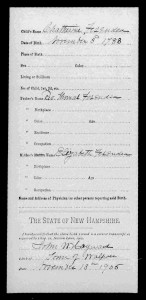 I was recently asked about the apparent disappearance of the eighteenth- and nineteenth-century vital records of Walpole, New Hampshire. The originals survived into the early twentieth century, but they are no longer to be found in the town clerk’s office in Walpole.
I was recently asked about the apparent disappearance of the eighteenth- and nineteenth-century vital records of Walpole, New Hampshire. The originals survived into the early twentieth century, but they are no longer to be found in the town clerk’s office in Walpole.
I did some digging. In New Hampshire, vital records for each town are located at the town level. Therefore, the original vital records books for Walpole should be housed with the town clerk. However, when I called the town clerk, she stated that the records currently in the town’s collection start in the 1850s. According to the clerk, the early town records were burned in a fire. She did, however, suggest that I call the Division of Vital Records Administration, New Hampshire Department of State, in Concord to learn more about the practices of preserving vital records in early New Hampshire.
According to the Division of Vital Statistics, the state of New Hampshire began implementing statewide registration of births, marriages, and deaths in 1848, but did not see compliance by every town/city. Moreover, when these vital records were sent to the New Hampshire Secretary of State, the collection was misplaced. Later, in 1888, the State of New Hampshire began publishing vital records, and included births/marriages/deaths at the end of each town report. However, this practice was not followed by larger cities and towns due owing to the scale of the records they oversaw.
Finally, between 1903 and 1906, the State of New Hampshire began collecting vital records from cities and towns in an effort to create a central repository for these public records. The State compensated town clerks for each index card sent; this collection is now housed at the Division of Vital Records Administration. I should add that 14 New Hampshire towns did not participate.
Reverting to the case of Walpole, it is certainly possible that the eighteenth-century records were lost in a fire after the 1903–6 statewide collection was created. If so, this would explain their disappearance from the Walpole’s town hall.
This seems to be an unfortunate pattern. Many of the town halls across New England were wooden structures that were susceptible to fire. Additionally, record keeping was not always reliable and quite often verbal offerings were translated and transcribed incorrectly due to phonics and and writing. The bane and brick wall of many a researcher.
this seems to happen more than we realize. I was in Buffalo, NY in 1994, looking for the graves of ancestors. I was told that the reason I could not find the graves was because ‘some’ neighborhood churchyard cemeteries were moved to Forest Lawn when the downtown area was expanding. No one knew what happened to the records for the reburials, they seem to be ‘missing’. To this day I am not able to find two great-great-uncles and their sister, however, I recently found their parents, a nephew, and possible aunt are buried in Forest Lawn and that at one time that part of the cemetery was known by a different name until the two cemeteries were merged as what is now known as Forest Lawn. I am sure the other missing family members are most likely buried nearby or in the same general area. It is just a matter of someone taking responsibility for those ‘lost’ or misplaced records and being able to find the locations of the graves I seek.
Mikki, I know how you feel. NY state law requires historians but some towns don’t seem to take this too seriously. Oxford, in Chenango, had a wonderful one, the late Charlotte Stafford. Cemetery records were, I think kept by the owners, or the funeral businesses, and so were not well conserved. My GGGGGrandfather, Levi Sherwood, was buried on his own land, which was absorbed into a cemetery, and now his stone is lost. Even tho he was a founder of the town and of the Masonic Lodge. (one of the still-existing Lodge members went out and looked for me, no luck) Have you tried Find A Grave? I was in NY about the same time you were, and even tho all this internet stuff is great, I still like personally going thru dusty old courthouse records…keep trying!
I had a similar experience in an Ohio town. When I visited the cemetery the mann in charge happened by and ask if he could help. I told him my story; he opened a closet door, brought out a large apparently OLD ledger, opened it and checked — then showed me a page which told that the graves of my 2 great grandfather and a son had been moved to his cemetery. He then took me to the site where they were re-buried.
Anna
Did you document when the fire was, and exactly what records were destroyed?
As a frequent researcher in Danbury, CT, we also have the problem of VR’s from the 18th century. But our dilemma originated from a somewhat different source. In April 1777, British troops under General Tryon attacked Danbury with the intent of destroying the military stores in town. They met resistance almost immediately and began burning shops and barns which probably contained military stores. They also torched the town meeting house, and with that fire, all VR’s and Probates for Danbury up to that date were forever lost.
What was not answered in this Blog, is this: The cards like the one originally posted are available to view and download on Ancestry.com. What I would be more interested in is are the original records from which those cards were made available, and if so where are they located?